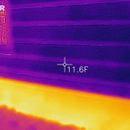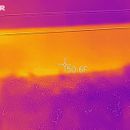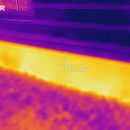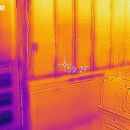Should I add more foundation insulation? FLIR still showing heat loss. Flir pictures attached.
I put R-10 foamboard on my above grade basement foundation. I also air sealed and installed R-15 roxul. Today is the first real cold day this winter and its currently in the teens. I went outside with my flir and noticed that even with the r10 foamboard the foundation is still glowing with heat. Prior to insulating the foundation the outside temp on the foundation was in the 50s. Its 17 out right now and the flir is showing the foundation is in the 30s. There is definitely a massive noticeable improvement inside. Unfinished basement temps are in the 55-60 range now. They use to drop into the 40s. Should I add another r-10 on the foundation? Is it supposed to be closer to outside air temperature? My siding is showing outside air temperature? Thats at r18+. I have r3 foamboard under the siding and r15 roxul inside. Plus homesote and sheetrock
Here are the FLIR shots.
The 11.6 is the current siding temp. Might be off as its 17 right now.
The 35.4 is the current foundation temp with in r10 foamboard.
The 50.6 was taken before insulation. I think the outside temp was in low 30s.
The 59.2 is the current inside basement temp.
This is a great visual on how much heat loss an exposed concrete foundation has.
GBA Detail Library
A collection of one thousand construction details organized by climate and house part













Replies
We saw this exact phenomenon in an interior-insulated foundation in Waterloo, ON (CZ 6). This was John Straube's personal house, which he did a DER on. Check out 8 Field Monitoring in the report below.
BA-1108: Hybrid Foundation Insulation Retrofits: Measure Guidelines
https://www.buildingscience.com/documents/bareports/ba-1108-hybrid-foundations-retrofits-measure-guideline/view
Quick takeaway: was this poorly performing insulation or thermal mass? The instrumentation and simulations said no. Instead, the most likely explanation is that the concrete foundation is "wicking" heat from the (warmer) ground, to the outside air.
We had multiple soil temperature sensors in this climate, and generally found that even though "frost depth" is deep into the ground, actual freezing temperatures deep in the ground were rare. Maybe there were some freezing periods in the top 6-12 inches, but deeper in the soil, it remained above freezing. One thing to remember is that it takes removal of energy to freeze the water in the soil, so you see these periods where the soil temperature is "locked" at 0 C/32 F, when the outside air is "trying" to freeze the soil. See pages 168-170 from my Master's thesis:
Hygrothermal Behavior of Interior Basement Insulation
https://uwspace.uwaterloo.ca/handle/10012/3242
Thanks Kohta. Very interesting papers.
I went back outside this morning and shot the foundation again. Its been pretty mild here and I think it was the soil temperatures soaking into the concrete foundation.
Prior to insulating the foundation it was at or slightly below the basement space temperature.
These FLIR shots speak for themselves.
I think you’re probably seeing heat coming up from the ground too. The much warmer basement temperatures now are an indication that your insulation is working.
I’ll offer some more info from the utility industry. When we do directional drilling in the winter (which sucks bigtime but still has to be done sometimes), we need the ground to remain unfrozen at our working depths below about 2 feet. It takes A LOT of cold weather before the ground freezes more than maybe 6” to a foot deep. If there is snow on the ground, the snow acts to insulate the ground and the frost depth won’t be as a deep as it would be in the same weather but without snow on the ground.
The ground at depth is much warmer than the surface even with below freezing air temperatures. If your winter is like ours in SE Michigan so far, you’re seen pretty mild winter temperatures so the ground is most likely warmer than you’d expect for this time of year.
Bill
Very timely post as I’m in the middle of the same effort at my house (using R15 2.5” polyiso) and noticing the same thing with my FLIR camera. The difference between insulated and uninsulated walls has so far been imperceptible on the outside with the camera but quite perceptible from the interior.
By the way, what's Homasote? (you mentioned that it's in your walls)
I searched on it and found their site, but it's not obvious to me which of their products it is: http://www.homasote.com/products
Homasote or Tentest are often use as generic names for tar impregnated fibreboard sheathing.
Its what they used on my 1958 house for exterior sheathing. It's similar to particle board.
I am amazed at the impact an insulated foundation has on total home heat loss. I had to set my 2 12k btu mini splits to a 2 degree lower set point to compensate.
Is there a way to calculate the heat loss? I insulted the entire foundation to r10. Half the foundation is above grade. The foundation is 28 inches high .
Yes, you can calculate the heat loss through a wall. The tricky part is that you probably don’t know exactly what your wall was losing to begin with, so about the best you can do is calculate the relative difference you have between the original wall and the new, insulated wall. The way to do this is to work out the BTU loss per square foot for your insulation ONLY for whatever temperature differential you want. This can use the definition for R value (Wikipedia has the equations). You know you reduced the heat loss by that much, but you won’t know an absolute value.
You can also make a rough measurement if you know how much energy you were using to maintain a given temperature BEFORE you added the insulation. To do this, normalize outdoor temperatures and ideally also wind speed and direction (which can be tricky), then work out the difference between a month of “before” and a month of “after” the insulation went up. The difference is your absolute savings, and also the amount of heat loss that was going through the uninsulated wall.
Bill